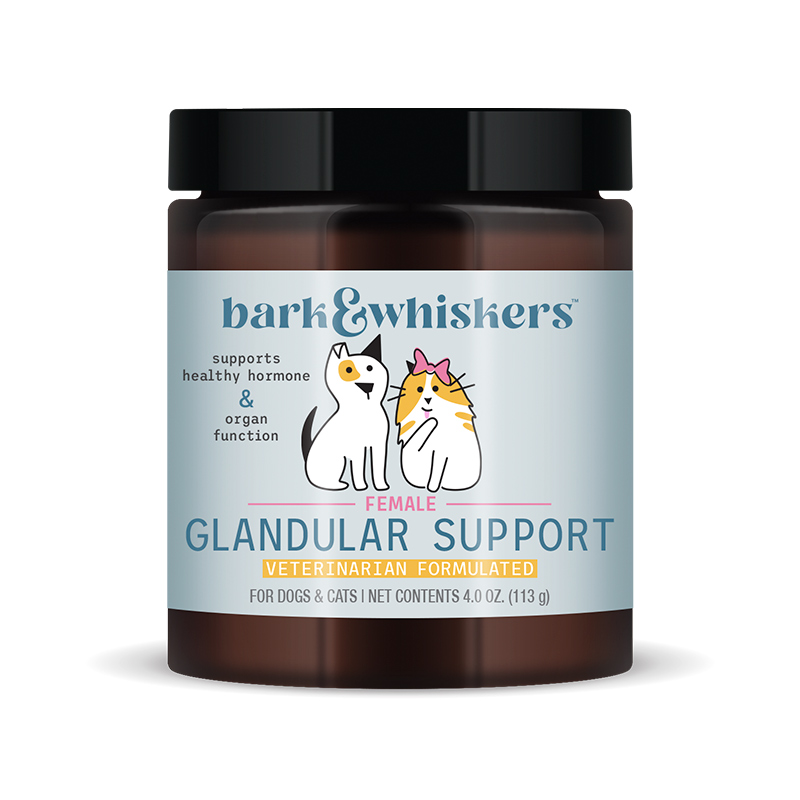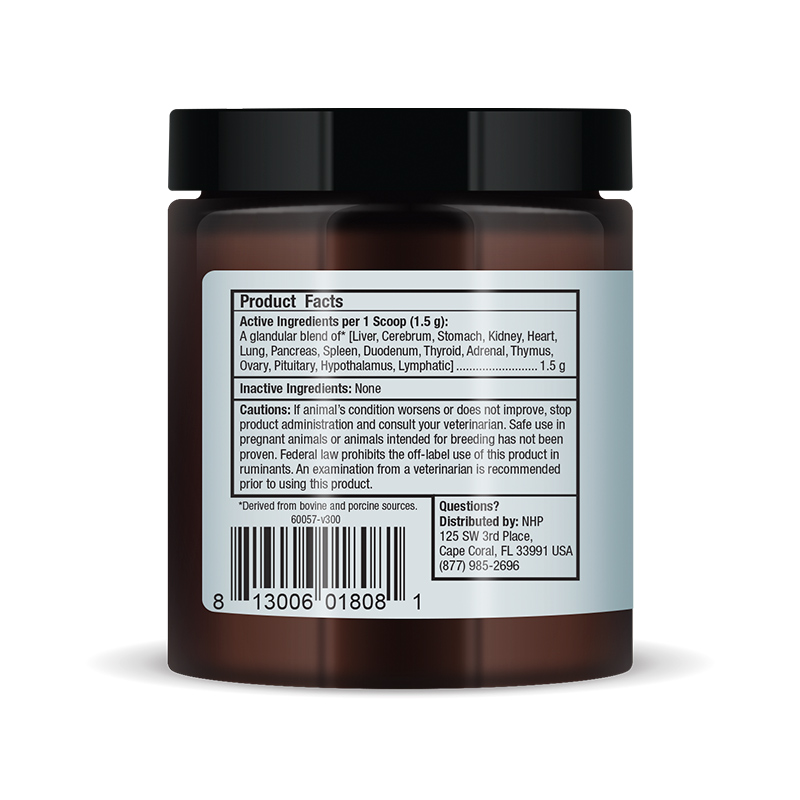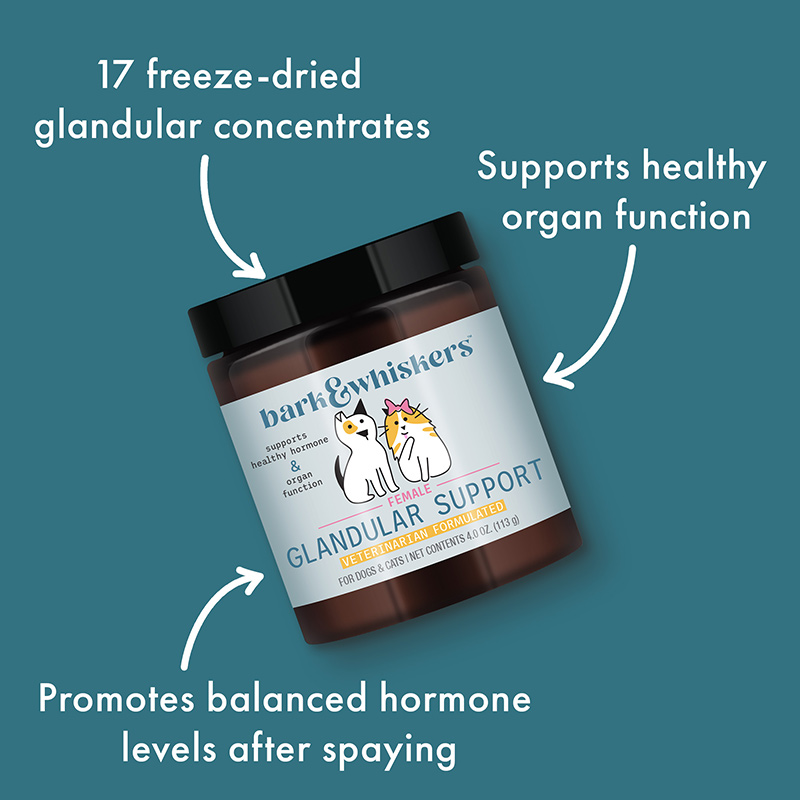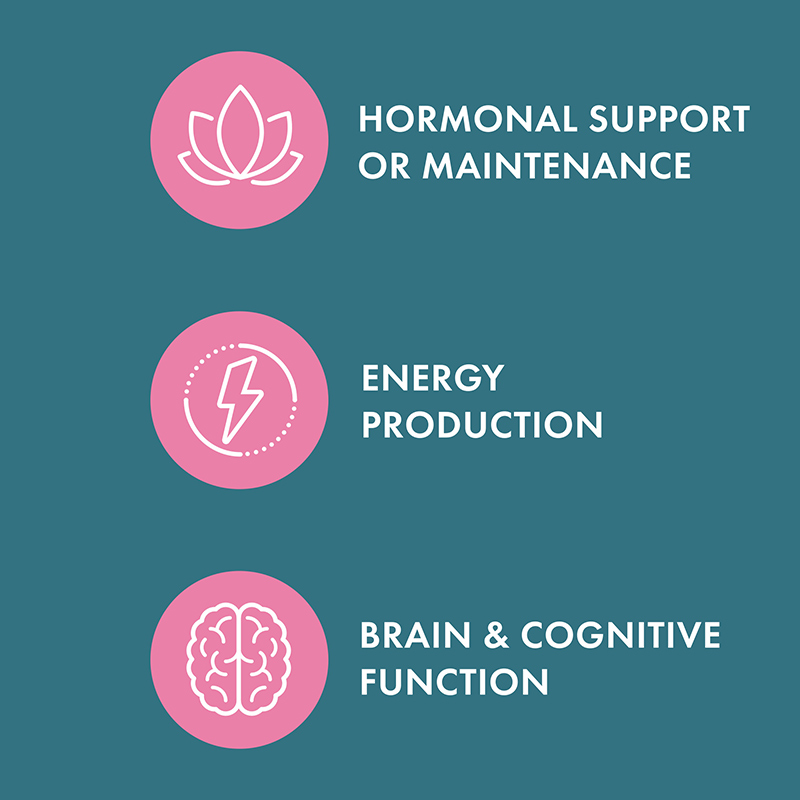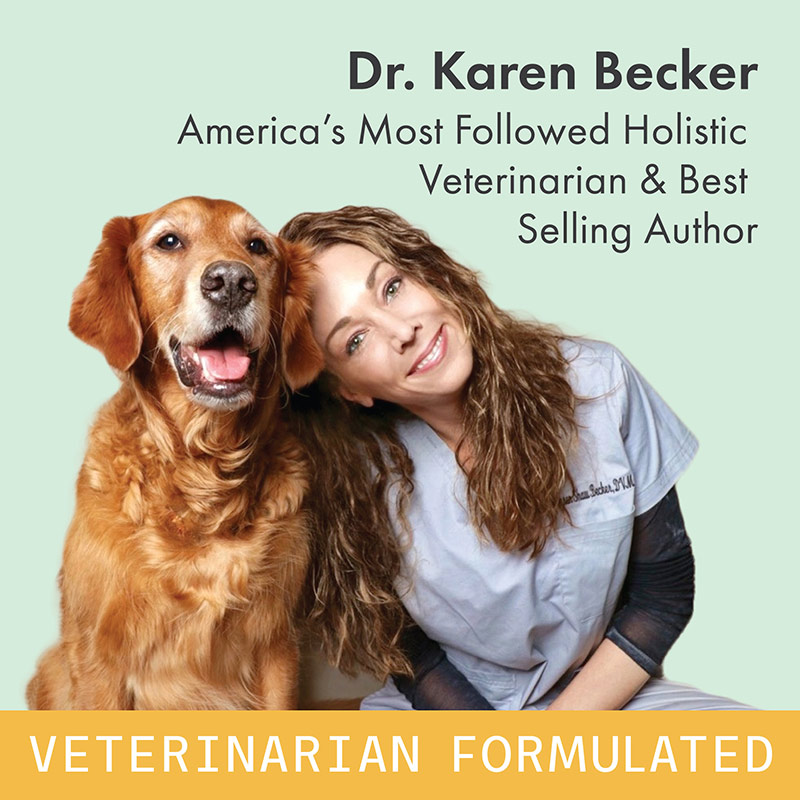
Support Your Pet’s Organs and Glands With the Profound, Yet Gentle, Approach of This ‘Like Supports Like’ Strategy
The idea of using organs and glands from one species to support the health of another dates back thousands of years. Long forgotten, but now making a comeback, find out how your pet’s brain, kidney, liver, adrenal, thyroid and other endocrine glands could potentially benefit from glandular ‘therapy.’
AT A GLANCE
- Bark & Whiskers™ Glandular Support is a formula of 16 (for females) or 17 (for males) freeze-dried glandular concentrates that provide natural components to support your pet’s glands and tissues.
- Bark & Whiskers™ Glandular Support provides dogs and cats with glandulars from range-fed, hormone-free and antibiotic-free cows and pigs, with the glandular material frozen and vacuum-dried to maintain its biological activity.
- Providing gentle yet profound support for a normal, healthy balance of hormones, this formula gives your pet extra support he may need to promote overall health.
It’s pure instinct for our pets’ wild canine and feline ancestors.
Their survival has always depended on hunting and eating other animals. Yet, as famished as these wild predators sometimes get, it’s not unusual for them to leave behind unwanted meat for scavengers.
However, there’s one type of meat they almost never leave behind...
The glands and organs. When animals catch their prey, the first parts they eat are the liver, adrenals, pancreas, kidneys, spleen, and other organs and glands.
What is it about these choice parts? Do these predators instinctively know something about them that many pet owners don’t?
Even more important, what role might these nutrient-dense organs and glands have played in the “survival of the fittest” among your pet’s wild ancestors?
There is something very special about these prime parts, and wild animals aren’t the only ones who know it. Humans have valued the use of animal organs and glands for thousands of years.
Known for Thousands of Years, Yet Severely Underappreciated and Underutilized
The oldest known medical document, the papyrus of Eber, describes the use of animal glands and organs for supporting health as far back as 1,600 B.C. Even the famous Middle Ages alchemist Paracelsus wrote about and practiced what’s called the “like supports like” strategy.
It’s a simple concept: If you want to support your liver health, you eat liver. If you want to support your thyroid health, you consume actual thyroid tissue.
The “like supports like” strategy – also known as “glandular therapy” – is based on the idea of using specific whole animal glandular tissues or extracts to support the healthy functioning of similar tissues in the body.
According to this approach, the glands or tissues from healthy animals provide natural components for repair and maintenance.
When another animal consumes these glands or tissues, these healthy, intact nutrients can supply his organs and glands with the building blocks they may need.
You may be wondering... How do these tissues or extracts find their way to the right organ or gland in the body?
Researchers searched for the answer to this question for years before they fully understood the answer. Eventually, they discovered that Paracelsus was on the right track way back in the Middle Ages.
Here’s what the researchers found: Cells are attracted to “like cells” in the body.
And they were able to test and prove their theory by injecting stained or radioactive cells into a subject animal, and then watching the cells find their way to and accumulate in the exact same tissue.
Even more remarkable was their other observation: The more damaged the cells in the subject animal, the greater the uptake of healthy new cells.
How Glands and Organs Can Support Your Pet’s Overall Health
The glands and organs of animals can contain a wide array of active components that aren’t found in muscle meat:
- Low levels of hormones for supporting a normal hormonal balance
- Pancreatic enzymes from pancreatic tissues to help digest food and absorb nutrients
- Endocrine enzymes from endocrine glands to support the normal production of hormones
- Enzymes from multiple glands and organs to support overall health and well-being
- Lipids and steroids to support overall health (heart, spleen, liver and kidney tissues are an excellent source of Coenzyme Q10)
- Phospholipids, omega-3s and other fatty acids from brain tissue to support brain health
- Amino acids and peptides to support glandular and organ health
Is it any wonder that an animal in the wild would devour their prey’s glands and organs first? I believe it’s one of the finest examples of an animal’s instinctive sense of knowing what their body needs…
The Rebirth of Glandular Therapy – A Real Boon for Pets
Holistic veterinarians like myself have been using freeze-dried tissue concentrates from healthy animals to support the health and vitality of our patients for many years. They’ve been an important part of my private practice for over two decades.
Using these gland and organ tissues gives you a very powerful way to support your pet’s overall health.
When your pet consumes these tissues, which are carefully dried to retain their biological activity, it provides her with uniquely-targeted extra support she may need for rebuilding her own cells and tissues.
For example, when your pet consumes heart tissue sourced from a healthy animal, she receives components specific to her heart that she wouldn’t normally get in her diet.
The real beauty of using glandulars, in my opinion, is that your pet receives all of the potential activity of the whole, healthy glandular tissue to support her own organ health.
Glandular therapy holds potential for a number of applications where gentle organ support may be useful, but I’ve found that one group in particular really benefits from glandulars – spayed and neutered dogs and cats.
Spaying and Neutering Can Take a Heavy Toll on Your Pet
Your pet’s endocrine system consists of tissues and glands that release hormones into his bloodstream. Much of your pet’s hormonal endocrine balance comes from hormones made in the testicles in males, and in the ovaries in females.
When a male dog or cat is neutered, his testicles are removed. Spaying removes a female dog or cat’s uterus and ovaries.
Neutering and spaying remove ALL of the tissues that normally secrete sex hormones, including estrogen, progesterone and testosterone.
Here’s the problem...
Your pet still needs those hormones. And they need them in the right proportions for normal biologic functioning throughout life. Without them, everything from their brain to their bones can be affected.
Since your pet’s body can’t survive without these important hormones, it finds an alternate way to get them: his adrenal glands. These are the only remaining tissues in your pet’s desexed body that can produce these hormones.
Over time, this double-duty takes a toll on your pet’s adrenals. They must do their own work – which involves regulating your pet’s metabolism, immune system, blood pressure and stress response – plus the work of the missing organs.
It's very difficult for these little glands to keep up with the added demand for sex hormones.
The bottom line is… Once your pet is spayed or neutered, his organ systems struggle for the remainder of his life to create and maintain a healthy balance of hormones.
Glandular Therapy: The Missing Link for Neutered and Spayed Dogs – and Maybe Even Cats?
Unfortunately, I learned about the catastrophic effects of traditional desexing the hard way – and at the expense of my patients’ well-being.
I am not against sterilization, but after the painful lesson I learned with my own patients’ health, I now use sterilization techniques that preserve normal endocrine function, unlike traditional neutering and spaying.
Traditional spaying and neutering are the only two procedures taught in school for animal birth control, so most veterinarians routinely perform these procedures. Sadly, to the detriment of their patients.
If your pet has been neutered or spayed, glandular therapy may help support her endocrine gland functioning.
And it can provide gentle, long-term natural support for hormonal balance.
Dogs are adversely affected by traditional desexing more profoundly than are cats. Fortunately for kitties, their endocrine systems are significantly different from dogs so they are not as severely impacted.
But even if she doesn’t need the same level of endocrine system support as her canine partner, your cat can still potentially benefit from the components provided by all the other glands just like her ancestors did, and like her wild cousins do today.
One Place Where You Won’t Find Glandulars Worth Feeding to Your Pet
So, where can you find high quality glandulars for your cat or dog?
You won’t find them in most commercial pet foods – at least not glandulars that you can feel good about feeding to your pet.
Commercial pet foods contain mostly muscle meat. Leftover organs and glands are typically rendered together with unsavory animal byproducts like beaks, hoofs and feathers and passed off as animal “meal.”
Any enzymes or other valuable components that might have been present in the raw material are now useless because of high-heat processing methods.
However, if you prepare your pet’s food at home, you have a unique opportunity to add a few healthy organs.
If you’re not feeding your pet a raw food diet with added organs, or if you’d like to provide your pet with all the other important glands and organs they don’t get in their current diet – including those lost with spaying and neutering – I have another option for you…
Introducing… Bark & Whiskers™ Glandular Support – The First and Only Customized Formulas for Male and Female Pets
While there are a variety of glandular support products on the market, here’s something that you won’t find anywhere else: complete customized formulas for male and female pets.
Male and female animals have unique needs. Females have ovaries, and the loss of those precious glands can affect them throughout their lives.
Likewise, male animals lose their testes when they are neutered, with potential lifelong effects. My Bark & Whiskers™ Glandular Support provides extra support for these missing glands in both males and females.
With my proprietary Bark & Whiskers™ Glandular Support, your pet receives as many as 17 different glandular concentrates, depending on whether you choose the Male or Female variety. Here are the glands and organs included in my formula:
- Liver
- Cerebrum
- Stomach
- Kidney
- Heart
- Lung
- Pancreas
- Spleen
- Duodenum
- Thyroid
- Adrenal
- Thymus
- Pituitary
- Hypothalamus
- Lymphatic
- Ovary (female version only)
- Testes (male version only)
- Prostate (male version only)
Other preparations on the market may contain one, two or maybe four glandulars.
But I felt it was important to include all 16 or 17 glandulars to provide your pet with all the potential benefits of these prime parts.
Why the Source of Glandulars Matters
I know you may be thinking… Where do all these glands come from, and how do I know they’re safe for my pet?
Good questions. Those were the first things I asked, too…
I completely understand that you would not want glands and organs from stressed animals that had lived their lives in crowded, inhumane factory farms.
Nor would I want to feed my pets tissues from animals that have been fed GMO feed or given hormones and antibiotics.
With these concerns in mind, I searched for a source from healthy, humanely-raised animals.
The glandulars in my Bark & Whiskers™ Glandular Support come from government inspected, hormone- and antibiotic-free cows and pigs raised in Argentina.
These animals are range-fed and spend their lives contentedly grazing in quiet, clean environments untouched by pesticides and herbicides.
Because of these ideal conditions, they have lower cortisol levels, an important factor with glands.
A product of the grass-fed meat industry, the glandular material is removed and immediately frozen and then vacuum-dried to maintain its biological activity.
Without question, it’s a product that I trust for feeding to my own pets to gently support their overall health. And you can feel good about giving it to yours, too…
Could Your Pet Potentially Benefit from Bark & Whiskers™ Glandular Support?
Glandulars offer potential benefits for cats and dogs in a wide variety of circumstances. Pets who can benefit from Bark & Whiskers™ Glandular Support include:
- Spayed and neutered dogs, of any age, to promote endocrine balance.
- Intact dogs, of any age, to support overall health.
- Cats, desexed or intact, of any age, to support overall health.
- Dogs and cats, who could use extra support for any specific gland or organ, especially liver, kidney or thyroid.
- Older pets experiencing normal, age related cognitive decline.
Clearly, this includes just about every pet. That’s why I am so excited to finally make this available for you.
Over the many years I’ve been using glandulars in my practice, I’ve seen profound metabolic shifts and positive results in my furry patients, and I’m eager to bring those potential benefits to your pet.
You may also know about my Canine Hormone Support, which is recommended for dogs only. It has some similar features, but some distinct differences.
Canine Hormone Support supplies the building blocks for supporting healthy hormonal balance and endocrine function in desexed dogs that are already showing signs of hormonal imbalance.
Bark & Whiskers™ Glandular Support (for dogs and cats) provides actual animal glandular tissues to gently support the healthy functioning of all of your pet’s glands and organs, endocrine system included.
If your dog is already showing signs of hormonal imbalance, then I recommend giving both Canine Hormone Support and Bark & Whiskers™ Glandular Support.
If your vet hasn’t yet diagnosed an endocrine imbalance or deficiency in your pet, then Glandular Support by itself may be enough to support your pet’s endocrine health and promote a normal, healthy balance of hormones.
A Profound Way to Support Your Pet’s Total Health…
Based on what I’ve seen in my own practice, I believe Bark & Whiskers™ Glandular Support is one of the most profound, yet gentle, ways to support your pet’s health.
I’ve witnessed animals whose owners were convinced that they had “checked out” for good only to come back with a zest for life after receiving glandulars.
Because glandulars offer such far-reaching potential benefits for your pet’s entire body, I heartily encourage their use for the majority of pets.
